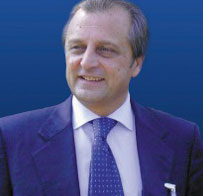Giancarlo Comi

ENG. Giancarlo Comi received a degree in medicine in 1973 and a neurological certification in 1977, both from Milan University. He joined the Department of Neurology, Scientific Institute San Raffaele, Milan University, in 1974 as an Assistant Professor. He is currently Professor of Neurology, Chairman of the Department of Neurology, and Director of the Institute of Experimental Neurology, at Vita-Salute San Raffaele University, Scientific Institute San Raffaele, Milan. His fields of interest are principally directed towards the study of the pathophysiology and treatment of multiple sclerosis. Professor Comi has authored and co-authored more than 800 articles in peer-reviewed journals, and edited eight books. He has a long-standing involvement as an active member of steering committees and advisory boards of many international clinical trials, mainly in the field of multiple sclerosis. He is the Vice President of the European Charcot Foundation (ECF) and a member of the Executive Committee of the European Committee for Treatment and Research in Multiple Sclerosis (ECTRIMS). Professor Comi has also served as President of the European Neurology Society and the Italian Society of Clinical Neurophysiology. He has recently been elected the President-elect of the Italian Society of Neurology for the period of 2010 ”“ 2012. He currently sits on the executive boards of various scientific associations and in the editorial boards of Clinical Neurophysiology, European Neurology and Neurological Sciences.
ITA. Giancarlo Comi si è laureato in medicina nel 1973 all'Università degli Studi di Milano e specializzato in neurologia nel 1977 presso la stessa università. Nel 1974 è diventato ricercatore presso il Dipartimento di Neurologia dell'Istituto Scientifico Universitario San Raffaele di Milano. Attualmente è Professore di Neurologia, Direttore del Dipartimento di Neurologia e dell'Istituto di Neurologia Sperimentale all'Università Vita-Salute San Raffaele di Milano. I suoi interessi si concentrano principalmente sullo studio della patofisiologia e delle cure della sclerosi multipla. É autore, singolo o in collaborazione, di oltre 800 articoli su riviste con referaggio e otto libri. Da lungo tempo partecipa attivamente a comitati direttivi e consultivi di molti esperimenti clinici internazionali, soprattutto nell'ambito della sclerosi multipla. É vicepresidente della Fondazione Europea Charcot e membro del comitato esecutivo del Comitato Europeo per la Cura e le Ricerche sulla Sclerosi Multipla (ECTRIMS). Ha inoltre presieduto la Società Europea di Neurologia (ENS) e la Società Italiana di Neurofisiologia Clinica ed è presidente della Società Italiana di Neurologia per il biennio 2010 ”“ 2012. Attualmente fa parte del consiglio esecutivo di molte associazioni scientifiche e del comitato redazionale delle riviste “Multiple Sclerosis”, “European Journal of Neurology” e “Neurological Sciences”.
Brain disorders and plasticity
Clinical observation indicate that acute damage in the Central Nervous System (CNS) is frequently followed by some degree of spontaneous recovery, nevertheless the traditional view in neurosciences was that the mature Central Nervous System has no possibility to regenerate and has little capacity to reorganize and repair itself in response to injury. From the beginning of the 1970s, basic, electrophysiological and imaging researches from many laboratories started to reveal that CNS does have some ability to reorganize itself after acute and chronic injuries. This ability is based on two mechanisms: brain plasticity and neurogenesis.
Brain plasticity is a broad term for the property of the human brain to adapt to environmental pressure, experiences, and challenges. It plays a major role in development and learning and it is variably reactivated when central and peripheral nervous system damage occurs. At the synaptic level, plasticity refers to changes in the efficacy of synapses. At the systems level, plasticity refers to modifications of neural connectivity resulting in changes in the neuronal networks that carry cognitive and behavioral implications.
Many factors, including neuromediators, metabolic pathways, immune pathways, protein synthesis contribute to brain plasticity at the molecular level. In the last ten years it became evident that neurogenesis do occur in the CNS and may also have a role in the mechanisms of repair. Moreover very recent studies indicate that neurogenesis may influence brain plasticity and both can be manipulated by physical (electric and magnetic stimulation) and pharmacological interventions.
The brain is the most complex biological system on the planet and the sources of functional impairment are many, ranging from the sudden loss of tissue due to a stroke or traumatic injury to the decades long neurodegeneration associated with Parkinson’s or Alzheimer’s disease. The neurological dysfunctions observed in brain disorders are always the result of a complex interplay between the damage and the repair mechanisms. How to manipulate these mechanisms in order to slow neurodegeneration and/or enhance recovery is one of the key therapeutic issues in neurology and neurorehabilitation.





